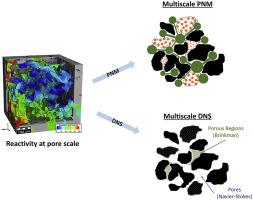Applied Geochemistry ( IF 3.1 ) Pub Date : 2021-06-08 , DOI: 10.1016/j.apgeochem.2021.105028 Saeid Sadeghnejad , Frieder Enzmann , Michael Kersten

|
Conventional and unconventional hydrocarbon rocks have complicated pore structures with heterogeneities distributed over various length scales (from nanometre to centimetre or even larger scales). Effective characterization of the properties of such rocks based on their digital twins is a challenging task. Digital rock physics (DRP) can be used to quantify the structural and morphological parameters of rocks directly and predict flow transport properties at the pore scale. Digital rock chemistry (DRC) or biology (DRB) applies when the changes in pore structures are due to interaction with solutes or microbial activities. Fluid–rock interactions or microbial activities complicate fluid flow by introducing new heterogeneities at the pore scale. DRP/DRC/DRB modelling approaches can achieve an understanding of spatiotemporal porosity/permeability relationships that develop at the pore scale during reactive flow or microbial activities. There has recently been a surge in publications on the modelling of pore-scale models. However, this approach has many challenges, from theoretical issues such as how best to combine rock properties at different resolutions to technical challenges such as performing simulations using pore-scale models that contain too many pores and throats. Multiscale pore modelling approaches are generally categorized using the number of scales represented, the minimum being a dual-scale pore model, in which both void and porous voxels (e.g., unresolved pores) are modelled simultaneously. Two common approaches that can be implemented to predict rocks' behaviour across different scales are direct numerical simulation (DNS) and pore network model (PNM). Multiscale PNMs received more attention because of their ability to model a wide pore size distribution at various scales, while multiscale DNS requires resource-demanding Navier-Stokes-Brinkman models in GB voxel space. An overview of the recent progress and challenges involved in modelling digital rock physics, chemistry, and biology of multiscale systems is presented here.
中文翻译:

数字岩石物理、化学和生物学:孔隙尺度建模方法的挑战和前景
常规和非常规油气岩具有复杂的孔隙结构,其非均质性分布在各种长度尺度(从纳米到厘米甚至更大尺度)。基于其数字孪生体对此类岩石的特性进行有效表征是一项具有挑战性的任务。数字岩石物理 (DRP) 可用于直接量化岩石的结构和形态参数,并预测孔隙尺度的流动输运特性。当孔隙结构的变化是由于与溶质或微生物活动的相互作用引起时,数字岩石化学 (DRC) 或生物学 (DRB) 适用。流体-岩石相互作用或微生物活动通过在孔隙尺度引入新的异质性使流体流动复杂化。DRP/DRC/DRB 建模方法可以理解在反应流或微生物活动期间在孔隙尺度上形成的时空孔隙度/渗透率关系。最近关于孔隙尺度模型建模的出版物激增。然而,这种方法面临许多挑战,从理论问题(例如如何最好地结合不同分辨率的岩石特性)到技术挑战(例如使用包含过多孔隙和喉道的孔隙尺度模型进行模拟)。多尺度孔隙建模方法通常使用表示的尺度数量进行分类,最小的是双尺度孔隙模型,其中空隙和多孔体素(例如,未解析的孔隙)同时建模。可用于预测岩石的两种常见方法 不同尺度的行为是直接数值模拟 (DNS) 和孔隙网络模型 (PNM)。多尺度 PNM 受到更多关注,因为它们能够在各种尺度上对宽孔径分布进行建模,而多尺度 DNS 需要在 GB 体素空间中使用资源要求高的 Navier-Stokes-Brinkman 模型。此处概述了多尺度系统的数字岩石物理、化学和生物学建模方面的最新进展和挑战。











































 京公网安备 11010802027423号
京公网安备 11010802027423号